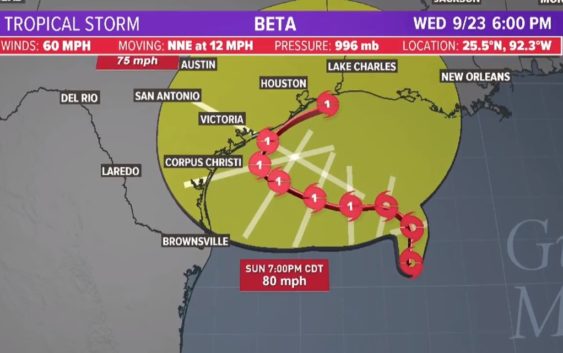- $40 million to go to underserved SC counties for Hurricane Helene recovery. Here's what you need to know.
- Family honors Air Force veteran Derwin Anderson Jr. after he died in June flash floods
- City of Wilmington addresses flooding on New Centre Drive
- Harnett County fire: Two homes damaged
- Medical examiner identifies 13th victim from massive flash flood in San Antonio
Tropical Storm Beta strengthens; hurricane and storm surge watches issued

Tropical Storm Beta now has 60 mile-per-hour sustained winds as it moves through the Gulf of Mexico.
HOUSTON — Tropical Storm Beta has increased intensity in the Gulf of Mexico and it’s expected to be a big rainmaker in Texas, according to the National Hurricane Center.
The forecast track for the Gulf system remains uncertain. It could become a Category 1 hurricane soon.
As of the 10 p.m. Friday update from the National Hurricane Center, Tropical Storm Beta had 60 mph sustained winds with gusts at 70. It was moving to the north-northeast at 12 mph. It’s 315 miles southwest of the mouth of the Mississippi River.
Storm surge and hurricane watches have been issued along the Texas Gulf Coast.
Current watches and warnings
Hurricane and storm surge watches have been issued from Port Mansfield to High Island. Significant coastal flooding may produce significant damage to beaches and dunes.
Tropical Storm Beta forecast cone
Tropical Storm Beta spaghetti models
Gulf Coast rainfall forecast (Euro model)
4 p.m. Friday update from the National Hurricane Center:
Interests along the western Gulf of Mexico coast should monitor the progress of the depression.
DISCUSSION AND OUTLOOK
———————-
At 400 PM CDT (2100 UTC), the center of Tropical Storm Beta was located near latitude 24.3 North, longitude 93.1 West. Beta is moving toward the north-northeast near 9 mph (15 km/h), and this general motion is expected through Saturday. A slow westward motion is forecast to begin late Saturday or Saturday night, and this motion will likely continue into early next week. On the forecast track, the center of Beta will approach western coast of the Gulf of Mexico Sunday night and Monday.
Maximum sustained winds have increased to near 40 mph (65 km/h) with higher gusts. Additional slow strengthening is expected through the weekend, and Beta could be near hurricane strength Sunday or Sunday night.
Tropical-storm-force winds extend outward up to 105 miles (165 km) from the center.
The estimated minimum central pressure is 1004 mb (29.65 inches).
HAZARDS AFFECTING LAND
———————-
SURF: Swells are expected to increase and reach the coast of Texas and the Gulf Coast of Mexico over the weekend, generated by a
combination of the depression and a cold front entering the northern Gulf of Mexico. These swells are likely to cause
life-threatening surf and rip current conditions.
Be prepared if tropical weather does come our way
BEFORE THE STORM
- Make a home inventory
- Have a current copy of your declarations page that has your policy number and your agent’s number
- Review your policy with your insurance agent to determine if you have adequate coverage
- Repair loose boards, shingles, shutters and downspouts to prevent them from becoming an issue in high winds or torrential rain
- Have an evacuation plan, and include plans for your pets
- Make sure your emergency equipment is in working order, including a battery-powered radio, flashlights and extra batteries. Also, make sure to gather all medicine, replenish your first-aid kit and stock a week’s worth of non-perishable food and water
- Charge your cell phone and fill your car with gas
- Program all emergency phone numbers
DURING THE STORM
- If you are advised to evacuate, leave as soon as possible. Retain all related receipts – they may be considered in your claim. If you aren’t in a recommended evacuation and you plant to stay home, stay informed by listening to weather alerts
- Keep windows and doors closed at all time, and, if possible, board them up with wooden or metal shutters
- Stay away from the windows and in the center of the room, or, stay in an interior room
- Avoid flood water, as it may be electrically charged from downed power lines
- Check on family members and friends
AFTER THE STORM
- Check to be sure your family members are safe
- If you did evacuate, wait for official notice that it is safe to re-enter your neighborhood and your house
- Document damaged property, and take photos and videos. Don’t dispose of any damaged items without approval
- Keep a record of any temporary repairs or expenses to prevent further damage to your property